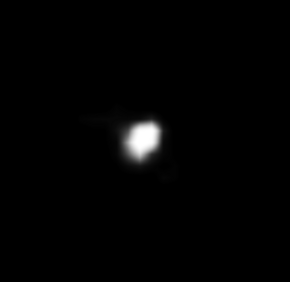- There is also a minor planet called 666 Desdemona.
 Discovery image of Desdemona | |
| Discovery | |
|---|---|
| Discovered by | Stephen P. Synnott / Voyager 2 |
| Discovery date | January 13, 1986 |
| Designations | |
Designation | Uranus X |
| Pronunciation | /dɛzdəˈmoʊnə/ [1] |
| Adjectives | Desdemonan, [2] Desdemonian, [3] Desdemonean [4] /dɛzdəˈmoʊn(i)ən/ |
| Orbital characteristics [5] | |
| 62,658.364 ± 0.047 km | |
| Eccentricity | 0.00013 ± 0.000070 |
| 0.473649597 ± 0.000000014 d | |
| Inclination | 0.11252 ± 0.037° (to Uranus' equator) |
| Satellite of | Uranus |
| Physical characteristics | |
| Dimensions | 90 × 54 × 54 km [6] [note 1] |
| ~13,000 km2 [a] | |
| Volume | 137400±37.5% km3 [7] |
| Mass | (1.237±0.436)×1017 kg [7] |
Mean
density | ≥0.66 g/cm3
[7] ~0.90 g/cm3 (assumed) |
| ~0.004–0.011 m/s2 [a] | |
| ~0.019–0.025 km/s [a] | |
| synchronous [6] | |
| zero [6] | |
| Albedo | 0.08 ± 0.01
[8] 0.07 [9] [10] |
| Temperature | ~64 K [a] |
| |
Desdemona is an inner satellite of Uranus. It was discovered from the images taken by Voyager 2 on 13 January 1986, and was given the temporary designation S/1986 U 6. [11] Desdemona is named after the wife of Othello in William Shakespeare's play Othello. It is also designated Uranus X. [12]
Desdemona belongs to Portia Group of satellites, which also includes Bianca, Cressida, Juliet, Portia, Rosalind, Cupid, Belinda and Perdita. [8] These satellites have similar orbits and photometric properties. [8] Other than its orbit, [5] size of 90 × 54 km [6] and geometric albedo of 0.08 [8] virtually nothing is known about Desdemona.
In the Voyager 2 images Desdemona appears as an elongated object, the major axis pointing towards Uranus. The ratio of axes of Desdemona's prolate spheroid is 0.6 ± 0.3. [6] Its surface is grey in color. [6]
Desdemona may collide with one of its neighboring moons Cressida or Juliet within the next 100 million years. [13]
See also
Notes
References
- ^ Benjamin Smith (1903). The Century Dictionary and Cyclopedia.
- ^ Harris; Lazzari (1997), Shakespearean criticism
- ^ Daileader (2005). Racism, misogyny, and the Othello myth.
- ^ Genova (1997). Power, gender, values.
- ^ a b Jacobson, R. A. (1998). "The Orbits of the Inner Uranian Satellites From Hubble Space Telescope and Voyager 2 Observations". The Astronomical Journal. 115 (3): 1195–1199. Bibcode: 1998AJ....115.1195J. doi: 10.1086/300263. S2CID 118616209.
- ^ a b c d e f Karkoschka, Erich (2001). "Voyager's Eleventh Discovery of a Satellite of Uranus and Photometry and the First Size Measurements of Nine Satellites". Icarus. 151 (1): 69–77. Bibcode: 2001Icar..151...69K. doi: 10.1006/icar.2001.6597.
- ^ a b c French, Richard G.; Hedman, Matthew M.; Nicholson, Philip D.; Longaretti, Pierre-Yves; McGhee-French, Colleen A. (2024-03-15). "The Uranus system from occultation observations (1977–2006): Rings, pole direction, gravity field, and masses of Cressida, Cordelia, and Ophelia". Icarus. 411: 115957. arXiv: 2401.04634. doi: 10.1016/j.icarus.2024.115957. ISSN 0019-1035.
- ^ a b c d Karkoschka, Erich (2001). "Comprehensive Photometry of the Rings and 16 Satellites of Uranus with the Hubble Space Telescope". Icarus. 151 (1): 51–68. Bibcode: 2001Icar..151...51K. doi: 10.1006/icar.2001.6596.
- ^ "Planetary Satellite Physical Parameters". JPL (Solar System Dynamics). 24 October 2008. Retrieved 12 December 2008.
- ^ Williams, Dr. David R. (23 November 2007). "Uranian Satellite Fact Sheet". NASA (National Space Science Data Center). Retrieved 12 December 2008.
- ^ Smith, B. A. (January 16, 1986). "Satellites of Uranus". IAU Circular. 4164. Archived from the original on 5 November 2011. Retrieved 29 October 2011.
- ^ "Planet and Satellite Names and Discoverers". Gazetteer of Planetary Nomenclature. USGS Astrogeology. July 21, 2006. Retrieved 6 August 2006.
- ^ Duncan, Martin J.; Lissauer, Jack J. (1997). "Orbital Stability of the Uranian Satellite System". Icarus. 125 (1): 1–12. Bibcode: 1997Icar..125....1D. doi: 10.1006/icar.1996.5568.

